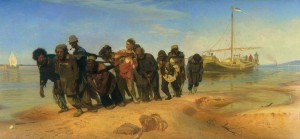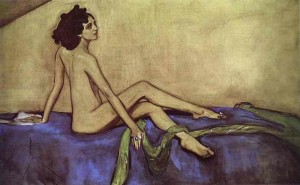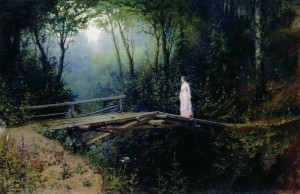Realistic Schools: Peredvizhniki

Barge Haulers on the Volga by Ilya Repin.

Barge Haulers on the Volga by Ilya Repin.
Peredvizhniki (Russian pronounced as Pear-rad-veezh-niki, often calledThe Wanderers or The Itinerants in English, were a group of Russian realist artists who in protest at academic restrictions formed an artists’ cooperative which evolved into the Society for Traveling Art Exhibitionsin 1870.
History
The society formed in 1870 in St. Petersburg under Ivan Kramskoi, Grigoriy Myasoyedov, Nikolai Ge and Vasily Perov’s initiative during a struggle of the avant-garde art forces of the country for democratic ideals, and in a counterbalance to the official center of art—the St.Petersburg Academy of Arts. The society developed the best traditions of the Artel of Artists headed by Kramskoi, who became the leader of the new association.
Peredvizhniki were influenced by the public and aesthetic views of Vissarion Belinsky and Nikolai Chernyshevsky. Like most Slavophiles, Chernyshevsky was a liberal and ardently supported the emancipation of serfs, which was finally realized in emancipation reform of 1861. Press censorship, serfdom, and capital punishment were viewed as baneful Western influences. His political activities led the authorities to prohibit publication of any of his written works, including his dissertation, although the dissertation eventually found its way to the artworld of nineteenth-century Russia. In 1863, almost immediately after the emancipation of serfs in Russia, the realization of Chernyshevsky’s work in practice came about through the protest of the fourteen students of the Royal Academy of Fine Arts. They manifested their protest during the annual Academy contest of works, declaring their secession from the Academy of Art. They drew the inspiration for this gesture of what could be considered as an apparent economic suicide from the ideas of “bringing art to people.” Seven years later most of the fourteen formed the kernel of the Society of Wandering Exhibitions, also known as The Wanderers or Itinerants (they thought to put their ideas into practice by organizing travelling exhibitions throughout the countryside of Russia). They founded a new artistic code that was based on social and political critique, as opposed to the pure aestheticism, and interpreted Chernyshevsky’s ideas by laying an emphasis on the subject matter of their works, justifying (like their friends and contemporaries Feodor Dostoevsky, Leo Tolstoy, Ivan Turgenev, and others) their activity by the attempt to make their art useful to society, and rejecting the “art for art’s sake” philosophy of concurrent academic tradition.
From 1871 to 1923 the society arranged 48 mobile exhibitions in St.Petersburg and Moscow, after which they were shown in Kiev, Kharkov,Kazan, Orel, Riga, Odessa and other cities.

Valentin Serov Portrait of Ida Rubinstein
As realist artists they showed the many-sided characters of social life, often with critical tendency. Their art showed not only poverty but also the beauty of folk way of life; not only suffering but also fortitude, strength of characters. In the humanistic art of Peredvizhniki there was resolute condemnation of the Russian autocratic orders; the emancipation movement of Russian people was shown with empathy (The Arrest of Propagandist; Refuse from Confession; Not Expected by Ilya Yefimovich Repin). The most important meaning in their art was social-urban life, and later in historic art depicting the people (The Morning of the Execution of Streltsy by Vasily Surikov).
The Peredvizhniki’s society, during their blossoming (1870-1890), developed an increasingly wider scope, and increasing naturalness and freedom of the images. In contrast to the traditional dark palette of the time, they chose a freer, wider manner with a lighter palette in depicting light. They aimed for naturalness in their images, and depiction of peoples relationship with their surroundings.
The society united almost all most talented art forces of the country. Among Peredvizhniki there were artists of Ukraine, Latvia, and Armenia. The society also showed the work of Mark Antokolski, Vasili Vereshchagin, and Andrei Ryabushkin. Important in the development of Peredvizhniki’s art was critic and democrat Vladimir Stasov, and Pavel Mikhailovich Tretyakov who showed them in his gallery and rendered them important material and moral support.
The authority and public influence of the society steadily grew, and the autocracy had to stop the initial tactics of clip (sic) and hunting of Peredvizhniki. Attempts were made to subordinate their activity, and raise the falling value of Academy of Arts sanctioned works.
By the 1890s in Academy of Arts structure was including Peredvizhniki art, and showing their influence in national art schools.
At the turn of the 20th century Peredvizhniki began to lose their depth as a reflection of a life. The influence of the society waned, and some of the artists began showing socialist ideas reflecting the development of working class movement. Many of the Peredvizhniki entered in the Soviet art culture, carried the realistic traditions of 19th century and helped form the art ofSocialist realism.
In 1898, their influence was superseded by Mir iskusstva, which advanced modern trends in Russian art.
The 48th exhibition of Peredvizhniki in 1923 was the last one. Most members joined the Association of Artists in Revolutionary Russia (AKhRR), whose members leaned on the traditions of Peredvizhniki and aspired to create works of art understandable by people and faithfully reflecting the Soviet validity.
Members of The Peredvizhniki

The Bridge in the Woods. by Rafail Sergeevich Levitsky.(1885-1886) The Stavropol Regional Museum of Fine Arts, Stavropol, Russia
Peredvizhniki artists include:
- Abram Arkhipov
- Nikolai Kuznetsov
- Nikolai Ge
- Nikolay Kasatkin
- Arkhip Kuindzhi
- Ivan Kramskoi
- Isaac Levitan
- Alexander Litovchenko
- Rafail Sergeevich Levitsky
- Vladimir Makovsky
- Vassili Maximovitch Maximov
- Grigoriy Myasoyedov
- Leonid Pasternak
- Vasily Perov
- Vasily Polenov
- Illarion Pryanishnikov
- Ilya Repin
- Andrei Ryabushkin
- Konstantin Savitsky
- Alexei Savrasov
- Valentin Serov
- Emily Shanks
- Ivan Shishkin
- Vasily Surikov
- Apollinary Vasnetsov
- Viktor Vasnetsov
- Nikolai Yaroshenko
References
- Gray, Camilla (2002). Russian Experiment in Art. London: Thames and Hudson. p. 9.
- Donnelly, Michael E.. “The Immortal Itinerants (Peredvizhniki)”. Russian Paintings Gallery. Retrieved 2009-02-12.
Source: en.wikipedia.org


This Post Has 0 Comments